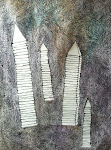A few summers back I pulled
into
Talihina, Oklahoma at midnight. The only place open was a 24-hour gas
station, where I purchased a Snicker's, a jug of Ozarka water and two
local papers. The content of these two papers was incredible: mass
shootings, a youth gun rally, a prison inmate named "Bulldog" in
jail
for 500 years bludgeoning his cellmate to death, political correctness,
fracking, Jesus, tomatoes. The story below is constructed entirely
out of content drawn from those two papers, the July 24, 2013 edition of
the McAlester News-Capital and
the July 25, 2013 edition of the Talihina American, "The Only Paper That
Gives A 'Hoot' About Kiamichi Valley." I think it's a particularly appropriate story for the present political moment. Call it, experimental journalism...
Just before midnight on
Saturday, July 13, Army Private Dustin Billy Cole, age 24, came out of his
apartment with a weapon and walked to the pool area of the Grandon Manor
Apartments. Officers arrived to find him holding a long rifle in a threatening
manner and the Tactical Response Unit was deployed. “We know this makes Dustin look bad,” the
high school principal said, “but we still support and love the Dustin we knew.”
Not long after, one day in
September 1962, Daddy went to the mountains to load logs onto his truck and
take them to the lumber yard. He was supposed to stop and get Mama, but instead
of stopping to get her, kept going. There were two things that Daddy was
terrified of, tornadoes, and motor vehicles. On the way home, he wrecked the
truck and was killed.
The warning signs are red,
hot and dry skin; a fast pulse; headache, dizziness and passing out.
Six year old Tayla McCarn had
no idea when she placed her small tomato plant in the ground it would
eventually take on such huge proportions.
Assume you received an offer
for $6.2 billion dollars—free haircuts and backpacks; cornmeal, salt and crab
legs; knives—would you dismiss such an offer without giving it careful study?
There’s no substitute for
blood. “It impacts all ages and often arises unexpectedly,” said John Armitage,
Oklahoma Blood Institute president and CEO.
Take cool showers or baths or
sponge baths. If you do not have an air conditioner and only have a box fan you
can try the following: Get a container like a dish pan, fill it full of ice and
water, and place the dish pan in front of your box fan and place it where it
will blow the cooler air on you.
Some say “Global Warming” is
the reason nature has gone berserk with more tornadoes, earthquakes, flooding,
hurricanes and volcanic eruptions. Such events are only local. There has been just
one worldwide cataclysm, but another is coming—Global Fire!
Officers were attempting to
speak with Cole. He fired one shot, backed into his apartment, armed himself
with an AK47 and began shooting. Two officers were critically wounded. Officer
Juan Obregon underwent surgeries to repair his leg. At 1:27am, Officer Robert
“Bobby” Harsby, age 32, was pronounced dead.








